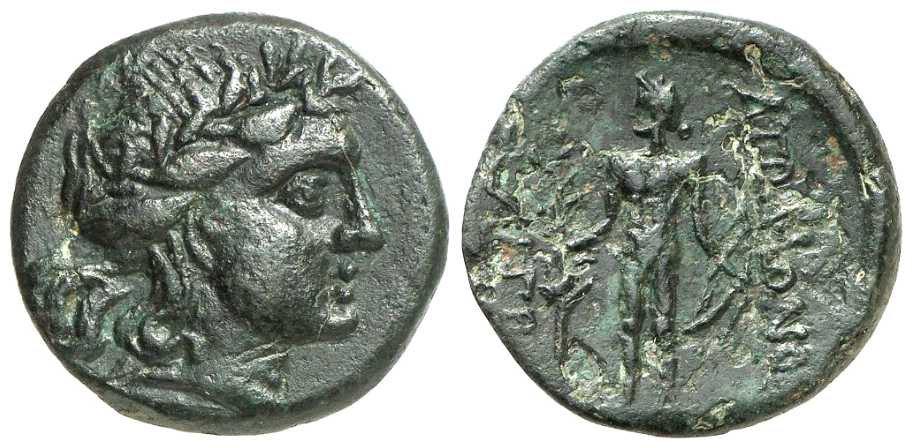| 300 BC - 150 BC |
Apollonia Pontica Thracia
Απολλωνία Ευξείνου Θράκη
Απολλωνία Ευξείνου Θράκη
| AE 23 |
SHH 5664 |
 |
| Parameter Obverse Reverse Notes Reference Provenance Donated Comment |
8.33 g 22.5-23.1 mm 2.3 eqmm
1:00
o'clock VF centering - / - σmax(SigmaTest, 240 kHz) = obv. 4.9, rev. 5.3 MS/m Head of Apollo right. Apollo standing facing, head left, holding in right hand a laurel branch in which a bird is perched, bow and two arrows in left hand; downward, to left AΠOΛΛΩNOΣ, to right IATPOY. ? BM Black sea ---; Löbbecke ZfN 15(1887)38; Pecunem 26/53, 7.12.2014; Stancomb --- Ex Heidelberger Münzhandlung 64/314, 20.11.2014; ex Auctiones 29/215, 2003 Griechisches Münzwerk, Berlin-Brandenburgische Akademie der Wissenschaften, 6.2019 A Tetradrachm with the same iconography was auctioned at CNG Triton XII/128, 5.1.2009, ex Sternberg XXV (25.11.1991), lot 82: "Providing a noteworthy counterbalance to his role as Smintheus, the "Mouse God", who unleashed plagues (Hom. Il. 1.39-52), Apollo also was associated with healing and bore the epithet Iatros, or "Healer". Although this latter function became more specifically the role of his son, Asklepios, a number of sacred sites remained dedicated to Apollo Iatros. One such site was in the city of Apollonia Pontika, and it is highly likely that the figure represented on this tetradrachm is the colossal statue of that god by the fifth-century BC Athenian sculptor Kalamis which, according to Strabo (7.6.1), stood in the local temple there, until the statue was carried off by the Romans in the early first century BC under the command of the Macedonian governor, M. Terentius Varro Lucullus (Plin. NH 34.18.39). While the exact find spot is unknown, the piece does originate from the western Pontic coastal region. Topalov’s attribution of the coin to Apollonia is circumstantial, and mostly based on similarities to particular 2nd-1st century BC bronzes of that city. However, there is no indication of a cult of Apollo Iatros ever existing at Apollonia. On the contrary, there is evidence of such a cult at Olbia, attested by an inscription on a statue base found there during archaeological excavations in 1962 (W.M. Calder III, “Stratonides Athenaios,” American Journal of Archaeology 75.3 [July 1971], pp. 325-6)." |